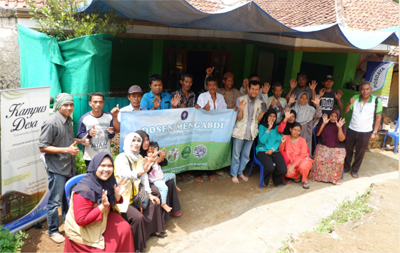Lecturer and Researcher of IPB University Initiated Innovation of Indigofera Village in Neglasari Village

The Institute of Research and Community Service (LPPM) IPB University once again assigned a team of lecturers from the Faculty of Animal Husbandry and researchers from the Center for Human Resource Development (P2SDM) to carry out community service activities on Sunday, (24/11). Through the Dedicated Lecturer (in bahasa Dosen Mengabdi) program, LPPM assigned Ir M. Agus Setiana, MS (Lecturer in Nutrition and Feed Technology), Muhammad Baihaqi, SPt, MSc (Lecturer in Animal Production and Technology), Ir M Yannefri Bakhtiar, MSi and LPPM facilitator, Tika Mazda for serving in the village of Neglasari, Bogor.
According to Tika, another potential of Neglasari Village is the large number of villagers who carry out sheep farming activities. In the first week of placement in the village, a social mapping activity was carried out and it was found that there were a number of villagers who owned a sheep business, so there was a need for socialization and education activities by IPB University lecturers to the community so that the economy of the Neglasari village community could improve.
The community service activities this time consisted of three material delivery sessions and continued focus group discussion (FGD) sessions and questions and answers. The first material was delivered by one of the initiators of the Family Empowerment Post (Posdaya) in the village around the campus who is also a researcher at P2SDM IPB University, Yanefri Bakhtiar.
Yannefri delivered about improving the welfare of village communities through the Village Campus program. “Village Campus is almost similar to LPPM IPB University’s Lecturer Servicing activities, namely the community empowerment program with the principle of sharing resources from the stakeholders involved (IPB University, community, government, and private) with the aim of providing solutions to agricultural problems in general,” he said.
Through institutions such as Posdaya, Yannefri appealed to the community to be actively involved and participatory so that they could get information and access more easily.
In the next material session, it was filled by IPB University Faculty of Animal Husbandry Lecturers on Sheep / Goat Rearing Management. Baihaqi said that one of the main factors of the lack of productivity of sheep farmed by the people of Neglasari Village was due to the management of animal maintenance that was not optimal. So far, the community only focuses on their animal feed, so they can sell sheep / goats that have a large quantity of weight so that the selling price is also high. However, if it is not supported by the health and hygiene maintenance of livestock, it is feared that it will actually cause physical and psychological disturbance to the sheep / goat.
“The management of raising any livestock, if done diligently and with patience will produce something good. If the livestock is healthy and worth selling, then the market will come naturally, “he said.
He also appealed to the community to carry out the maintenance management and marketing process of sheep in groups by prioritizing the principle of mutual assistance. This was done so that all the people of Neglasari village who had sheep or not, had the same benefits. According to Yannefri, this was also able to bring up the image or label for Neglasari village as a pilot village for sheep or Sheep Education for other villages.
Meanwhile, the Chairperson of the Sheep Livestock Group in Neglasari Village, Sukri, expressed his readiness and the villagers to manage their sheep raising. Such as bathing sheep regularly, maintaining the physical health of sheep by shaving fur and cutting the nails of sheep, as well as maintaining the sheep pen to avoid dangerous diseases.
Then the last session was filled by Lecturer of the Department of Nutrition and Feed Technology, Ir Agus Setiana. In his presentation, Ir Agus conveyed material about quality and easily cultivated sheep feed plants, namely Indigofera plants. Based on research results, the protein content in Indigofera is greater than other types of grass.
Indigofera is a high quality forage feed source, can function as a reserve of forage feed, as well as prevent erosion and fill empty areas to be productive. But so far the community believes that giving large amounts of grass will affect the weight of their livestock.
“In general, farmers provide fodder in the form of grass such as grass, rice straw and other types of grass. Even though such types of feed are only rich in energy sources, not to form the weight of the cattle themselves, “said Agus.
On this occasion the idea emerged to make Neglasari village an indigofera village. This can provide selling points as well as characteristics for the sheep herds in Neglasari Village.
“I am ready to go back down to the village, if the Neglasari people want to be guided further on sheep feed, namely indigofera. I hope Neglasari Village can become a pilot village for the sheep breeding sector for other campus villages and even villages in West Java,” he added. The service of the Dedicated Lecturer was closed by giving 300 indigofera seedlings to the village community present. (NR)
Keyword: Indigofera Village, Serving Lecturer, Livestock Village, LPPM IPB University



